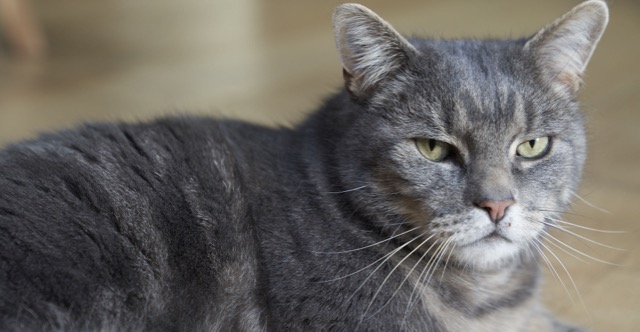
"He makes his wishes known," said Lou Tyack of West Oxfordshire Cats Protection. "He's a real little corker, this one." She handed the small black kitten to me who squeaked in protest. He was not frightened, merely indignant. His fur positively bristled with outrage as he realised he was being transferred to an unknown female.
George's early life had been spent with Lou Tyack in a cat chalet at the bottom of her Oxfordshire garden. Four kittens had been rescued as a wild litter and handed over to Lou - two black ones and two black and white. I had heard of them while lying on my back with my legs in table top position during a pilates class. As we drew in our muscles and indented our stomachs to get the second leg up to table top, one of my classmates turned her head in my direction and whispered: "Do you know that Lou has some kittens."
Kittens in October are rare, particularly kittens born in the wild. It's normally too late in the year for kittens to survive the winter and most female cats don't come on heat so late. Nature knows the effort of pregnancy may well be wasted. The only winter kittens are those produced by unscrupulous pedigree breeders or equally unscrupulous low life people who think they can make a few extra pence by selling kittens as Christmas presents. These wild kittens, the tiny black male and his three sisters, would probably have died that autumn. How did they arrive so late into a cold world so unfriendly to wild kittens? Perhaps their mother was as fearless and irrepressible as her son was to be, and just fancied a handsome passing tom that autumn despite it not being the right season for cats living wild.
Her four little kittens, if by some miracle they had survived in the wild, would have grown up feral. Their mother was just one of the many unknown cats who live a hidden life in the wild sheltering in damp hedges, or dusty derelict buildings or creeping into factories at night for the warmth left over from day time work. Some of them, the best survivors, are wild from birth, others are pets that have got lost, still others are pets that are thrown out by owners who no longer want them. Their lifespan is often less than two years, as they scrounge for food among the dustbins or try to keep themselves alive by hunting rabbits and rats in the wet fields. For an entire tom cat, it is a life of roaming in search of sex, caterwauling around the roof tops, or dodging the gamekeepers and their guns. For the un-neutered females it is a desperate and short life bearing litters of kittens. Near starving mothers do their best to rear their offspring but few of them survive.
The tiny black kitten and his sisters were alive thanks to Cats Protection and Lou's bottle feeding. But it was unusual to find unwanted kittens in a rescue centre that time of year and I had thought I would have to wait until Spring. I couldn't adopt an adult cat. A kitten was what I had to have, as in 2006 I was spending part of the week in London and part of it in Oxfordshire. A young kitten could be acclimatised to the car and would grow up relaxed about having two different territories. An older cat would have hated each journey. So, though there were cats more desperately needing homes, I had to have a kitten. and a young one at that.
A black kitten was my choice, because black is the least popular colour. Tabbies, gingers, tortoiseshells, blues and whites are quickly chosen out of the rescue pens regardless of their temperaments. Black and whites are not much desired but are taken eventually. In rescue centres where the public are allowed to walk by looking at the cats, they often fail to give black cats even a second glance. Friendly black cats will walk hopefully towards the passing human only to be ignored. Taking a black kitten was the least I could do, to help Cats Protection and the rescue movement in general. I also wanted a black cat because my last cat, Fat Mog, had been strong minded and black. Mog had been put to sleep with kidney disease about two or three months earlier.
A young kitten, as young as eight weeks, would grow up thinking car journeys were a normal part of life. "I can't give him to you yet," Lou had said a week earlier. "He's eight weeks old and he's eating solid food but he still likes his bottle. I don't want to wean him too early if he wants to continue on the bottle." Obviously the small black kitten, rather me or Lou, had taken charge of the the timing of his adoption.
I named him George because I knew he was valiant and irrepressible, and I hoped he would grow up to be loving and gorgeous.






